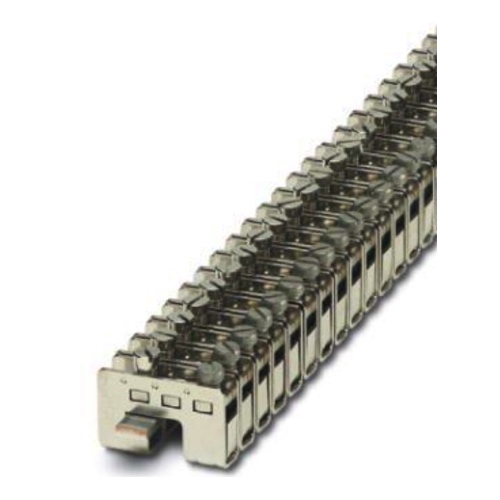Power Terminal Blocks

Electrical systems require essential components known as power distribution blocks in order to safely and effectively handle as well as distribute high levels of current and voltage. They are invariably found in the kinds of equipment that draw a lot of power: heavy-duty industrial machinery that operates lucrative businesses, from panel-building to switchgear manufacturing.
Terminal blocks for power applications often have robust clamping arrangements—like screws, bolts, or springs—that hold a wire firmly in place. The clamping arrangement ensures that the wire is securely in the terminal block and will not come loose. A wire that comes loose from a terminal block can lead to a variety of dangerous situations, not least of which are an electrical arc and an electrical shock. Some terminal blocks have features that enhance their safety even further, like a plastic cover over the live parts of the terminal block, or a plastic "barrier" that prevents you from touching a live part of the terminal block accidentally.
The power terminals found in many distribution panels and enclosures use the artifice of modular design to permit the easy growth and installation that is required for them to function as true power interfaces. They are often designed to allow exponential scaling of the power interface, using the same blocks that make them perfect for just about all common forms of building and scaling within the power interface.
FAQs
Do splicer blocks free up panel space when installed on a DIN rail?
Yes, splicer blocks free up panel space when installed on a DIN rail by providing a compact and organized solution for connecting multiple wires, reducing clutter and optimizing the use of available space.
Terminal Block Basics
Single Level Pass Through Terminal Blocks are used to connect two wires together with a common junction point. This is helpful when a component needs to be disconnected or isolated within a circuit. These are the most common types of terminal blocks in industrial applications.
Ground Terminal Blocks function almost exactly like most pass through terminal blocks with one exception: they are grounded. These terminal blocks have a metal connection from where the wire is terminated, all the way to the bottom of the block where it will clamp into the panel. This allows for an electrical circuit to be grounded without running a wire to the main ground connection on a breaker or surge protector.
Fused Terminal Blocks function almost exactly like most pass through terminal blocks with one exception: the presence of a fuse. This fuse provides protection for components from too much voltage or current.
Multilevel Terminal Blocks are used to connect two wires together with a common junction point, just like single pass though terminal blocks, but with the advantage of making two electrical connections in the same block. These blocks also incorporate fuses and can be grounded.
Disconnect Terminal Blocks are similar to fused blocks, however the disconnect stops the flow of electricity by lifting a lever on the terminal block. Unlike fuse blocks, they are a more permanent solution, but will not provide any protection in the event of a power surge.

